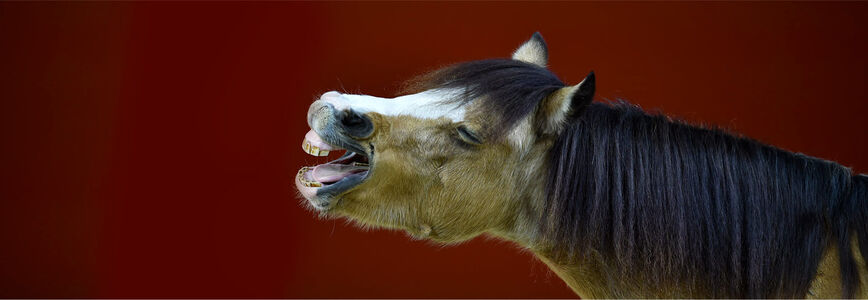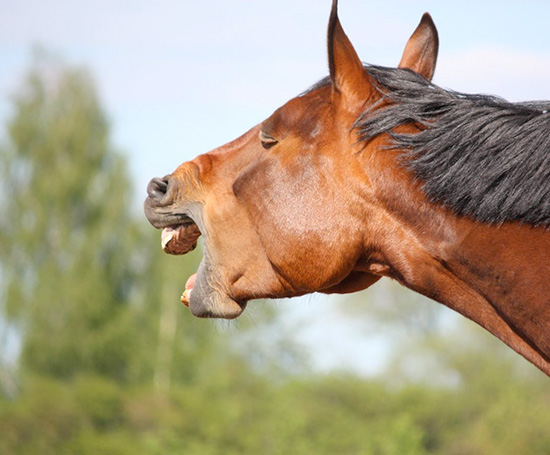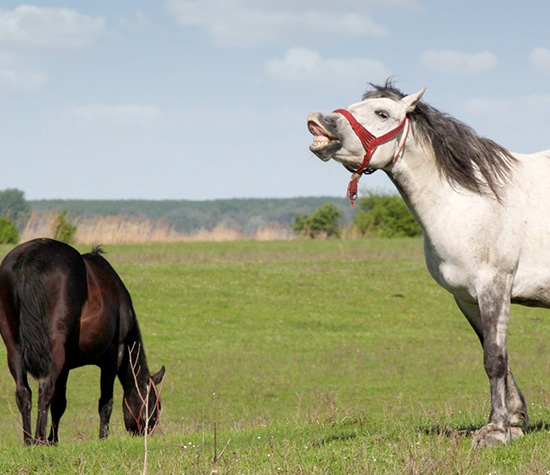
Horses communicate by means of sounds - whether neighing, bubbling or snorting - learn more about their meaning.

The two Friesians obviously get on very well - this is where they would most likely "bubble" at each other
Apart from pure body language, horses also communicate through sounds. As with us humans, every horse's voice sounds different. The "neigh" is used in different situations and can be gentle, expressive or scream-like. At a long distance, it is used to find out whether other members of the same species are nearby or to draw attention to itself. If a horse is alone and separated from its mates, it may, for example, try to make contact with the others by loud, long-drawn-out neighing.
When horses neigh, with a lot of emphasis, it can also become a scream or a roar, but this only happens in exceptional cases. In this way, the animals give expression to an extreme emotion such as fear or anger. Mares also sometimes make use of this very clear announcement when they feel harassed by an impetuous stallion or are not left alone despite having already been mated.
Horses usually whinny softly and gently when they hear a friend coming and the friend is not far away. This soft and somewhat guttural sound, which is similar to a grumble, is called "bubbling" and can often be understood as an invitation to come closer. Horses also use this friendly sound towards humans, especially in connection with food, but also simply as a nice greeting.
Mares that have foals also blubber to call their offspring. It can be observed that the little ones recognise these sounds very early and orientate themselves by them, but cannot yet identify whether the gentle neighing is coming from their mother. They only learn to distinguish the voices as they grow up.
Stallions often use a very deep and long blubbering sound to arouse the interest of mares, as if to say "Look, I'm a great one!". Very confident horses can sometimes also be recognised by a short and piercing neighing cry. If there is food, it is not uncommon for it to sound very energetic and expressive.

Snorting also has several meanings in communication and must be interpreted depending on the situation. For example, a loud, repeated snort is an indication to conspecifics that danger is imminent. The same applies when the animals inspect unknown objects that are not entirely familiar to them, but which have nevertheless aroused their curiosity. With a loud snort that sounds a bit like a snore, they want to say: "Be careful, I'm not sure if it's safe here". Some horses also make the same sound when they pretend to be frightened in their exuberance, but this is meant purely playfully.
However, when horses snort during work while riding or lunging, it is a sign of relaxation and well-being. The four-legged friends are content and calm, which is shown by the fact that the snort sounds drawn out and less alarmed.
When horses actively blow air through their nose, they want to express that they are extremely comfortable and content. It is a sign of great affection when animals "blow" at each other, the same is true for humans. It is comparable to a kiss and in fact a horse understands it as such when you also "blow" at it as a human. Also, when horses are surprised, blowing through the nose is not uncommon.
A high-pitched, piercing squeal is also heard from horses in some situations. It can be a sign of anger and exuberance, but it can also be a warning. For example, when horses, especially mares, first come into close contact with a conspecific, they will occasionally squeal to communicate their excited state. Often, one foreleg is stomped on the ground at the same time. But there is a fine line between a joyful squeal and a warning squeal during a mutual sniffing: a squeal can quickly be followed by an aggressive action such as a kick if the sound is emitted out of displeasure. Many horses also squeal while they are running wild, bucking or fighting.
Another sound in the animal's sound palette is the roar: It can be heard when a horse is unsettled, angry or even afraid. The deep, throaty sound is intended to intimidate and scare off conspecifics or objects that frighten the four-legged friends.